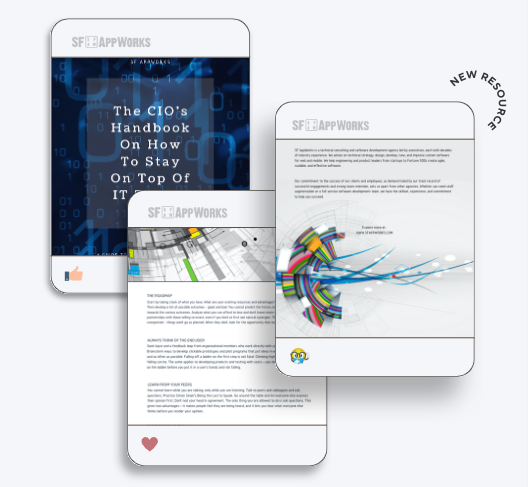To stay afloat in today’s digital landscape, large corporations cannot afford to neglect or underthink their approach to enterprise web development. Good enterprise web development can create positive user experiences, improve customer satisfaction, and optimize company efficiency. But poorly designed web development can lead to lost sales, lower conversions, and security attacks.
This article is an SF AppWorks dive into what comprises enterprise web development and how to develop robust web apps, services, and websites that will increase efficiency, security, and sales.
What is Enterprise Web Development?
Enterprise web development encompasses the corporate website, web applications, and enterprise software. While these may incorporate different web tools, they are often integrated and leverage similar enterprise systems, frameworks, servers, and databases. Each of these tools is essential for growing and managing a large corporation’s digital success.
How Does Enterprise Web Development Stand Apart?
While enterprise web development is simply a process to develop a website or an application for enterprise-level business, as innovations in web technology are advancing at an alert pace, websites and web applications are only expected to become more exciting to both businesses and end users.
Enterprise websites and web applications are typically built for mid to large-sized organizations, so it’s not uncommon to require many more features and tools than a regular website.
The Enterprise Content Management (ECM) system is also at the next level of complexity and must constantly adapt to numerous requirements of various stakeholders (customers, investors, partners, suppliers, and others).
Furthermore, enterprise web development often implies the use of:
- Branding Tools and Strategies
- Content Development
- Management Techniques
- Storage Management
- Software Integration
But the crowd of investors, partners, and suppliers always have a focus on delivering a more engaging user experience. That's why user testing sessions, constant improvement of site speed and UX, and the need to be adaptable to expanding operations in the future are typical strategies of enterprise web development.
The Corporate Website
This is the company’s online presence and a powerful marketing and sales tool when the user interface is well done. Potential customers are much more likely to bounce if the page doesn’t load in under 3 seconds, for example.
This can be incredibly daunting for enterprises with large volumes of content. To help pages to load faster, many enterprises utilize Enterprise Content Management (ECM) systems.
Related: A Step-by-Step Website Redesign Project Plan
Get a Free Copy of 'How To Tackle A Website Redesign'
%20(1).png?width=578&name=website%20redesign%20resource%20image%20(2)%20(1).png)
Internal and External Web Applications
Corporations can use web-based applications internally for many operations and workflows like managing teams, projects, and intercommunication. Web applications can also be tools and services that customers can access from mobile apps or the corporate website.
Web apps offer a wide range of utility that, if built well, create a seamless and connected suite of tools and functionality for your users.
Enterprise Software
Enterprise software is generally used internally for managing daily activities like:
- Accounting
- Recordkeeping
- Automation
- Project Management
Enterprise software can facilitate key processes or integrate several systems. Software development usually depends on the needs and size of the organization.
Related Link: The 3 Main Types of Application Development Methodologies
Critical Elements of Well Executed Enterprise Web Development
Regardless of what web tool you’re developing for an enterprise, each web development project requires several different components.
2. A Web Development Framework
3. An Efficient Life Cycle Model
4. A Well Mapped Development Process
5. Stringent Security Requirements
A Well Designed Tech Stack
A tech stack refers to the frontend and backend development of a web application. Frontend development is client-side coding that is interpreted by web browsers and enables functionality and a website’s design. Frontend developers primarily code in:
- HTML
- CSS
- JavaScript
- JQuery
Backend development is server-side coding that enables the webserver to interpret and execute web app functions that access databases, frameworks, and enterprise systems. Backend developers for enterprise web development primarily code in Node, Python, PHP, or Java.
Related Link: Three Dynamic Models of Innovation
Check Out This Video on Digital Adoption for Enterprises.
A Web Development Framework
A web development framework is a backbone set of tools, libraries, components, and resources that a developer can use to build applications, services, and websites. The framework is built on a pre-defined infrastructure and has templating capabilities for presenting information, designing information flow, and accessing data resources. At the enterprise level, developers often use frontend and backend frameworks because they offer proven, stable, streamlined environments for fast deployment.
Popular Frontend Enterprise Frameworks:
- Bootstrap 3
- Angular
- Vue.js
- React
Popular Backend Enterprise Frameworks:
- Spring
- Hibernate
- Apache Sturts2
- Linux
- PHP
- AWS (for cloud-based applications)
Common Databases Used by Enterprises:
Utilizing proven solid frameworks is essential for stronger security, complex functionality, and less testing, which leads to faster deployment.
Related: Digital Transformation Roadmap: A Step-by-Step Guide + Examples
GET A FREE COPY OF 'HOW WE INCREASED WEST ELM'S WEBSITE SPEED AND USER EXPERIENCE WITH REAL USER DATA: A GUIDE TO OPTIMIZING CORE WEB VITALS'
%20(1).png?width=479&height=340&name=web%20development%20resource%20-%20mockup%20(3)%20(1).png) Is Your Website Slowing You Down? Are potential customers bouncing before they even see your amazing products or services? You're not alone! This free guide will be your one-stop shop for transforming your website's speed and user experience.
Is Your Website Slowing You Down? Are potential customers bouncing before they even see your amazing products or services? You're not alone! This free guide will be your one-stop shop for transforming your website's speed and user experience.
An Efficient Life Cycle Model
An enterprise web development life cycle is the step-by-step process for developing apps, services, and websites. The corporation needs to define an efficient system for designing, building, testing, and deploying web apps.
Many corporations utilize the Agile life cycle model because it focuses on collaboration and teamwork. The Agile model defines all aspects of the development process from planning, requirements analysis, design, development, testing, and deployment.
Want to incorporate the Agile life cycle model into your next web development project? Contact SF AppWorks to learn more about their Agile Rapid Prototyping methodology.
Related: E-commerce Development Company in USA With Top E-commerce Services
Check out This Video On What Could Happen If You Don't Use Rapid Prototyping.
A Well-Mapped Development Process
In addition to a solid life cycle model, well-executed enterprise web development relies on a well-mapped development process specific to the corporation’s size, needs, and resources. The development process should outline everything from:
- Design documentation
- Research
- Specifications
- Integration analysis
- Design layout
- Quality assurance
- Maintenance and support
Related Link: Conducting a UX Audit in 7 Steps
Stringent Security Requirements
According to a Verizon 2020 Data Breach Investigations Report, web applications are the biggest target for security attacks because of their growing complexity. In 2019, attacks against web app servers accounted for 75% of breached assets.
And unfortunately, most security breaches happen because enterprise web apps are not fully compliant with security standards and contain vulnerabilities. To fortify web applications, companies need to:
- Test inputs for vulnerabilities like SQL injections.
- Use passwordless authentication
- Fortify web apps with a web application firewall (WAF)
Get A Free Copy Of 'Actionable Steps To Digital Transformation & Real-World Examples On How Companies Made Significantly More Money Than What They Invested'
%20(1).png?width=340&name=digital%20transformation%20mockup%20(2)%20(1).png)
Well-Designed User Interface (UI) and User Experience (UX)
A Forrester report found that by improving UI, corporations can increase their conversion rate by 200%. By enhancing UX, corporations can increase conversion rates by 400%. To do this, enterprise websites and applications need to utilize adaptive web design to customize the UX depending on the user’s device. To create an optimal UX, the UI must have:
- Responsive images
- Fluid layout
- Engaging media queries
Experienced and knowledgeable UX developers are essential for well-designed enterprise web development.
Related Link: What is Rapid Prototyping?
Crucial Characteristics of Enterprise Web Apps and Software
Consider these three main features of a successful enterprise web application of software:
Scalability
Scalability is a must-have characteristic of any enterprise web app or software and can help sustain the competition. The growth of a software product depends on if it was designed to adapt, on its scalability and functionality.
Interoperability
To ensure connectivity, during the enterprise web development process, you may need to interconnect the devices or the networks.
Performance
In order to generate profits and higher ROI, an enterprise web app/software has to be performant. Frequent downtimes can halt the business processes of a large enterprise, that is why performance is a must-have characteristic of a web app.
Get a Free Copy of 'CIO's Handbook on How To Stay On Top Of IT Trends'

Enterprise Web Development is Essential For Growth
Companies that define, develop, and focus on building strong enterprise web development will reap the benefits of increased conversions, sales, and customer satisfaction. Utilizing web apps internally and externally can increase efficiency, improve customer UX, and speed up workflow and communication.
Well-designed enterprise websites, apps, and services leverage:
- Efficient tech stacks and frameworks
- Optimal life cycles
- Defined development processes
- Rigorous security requirements
- Robust UI and UX design
SF AppWorks is a trusted digital agency specializing in integrating software platforms, improving user experience, and optimizing web applications for increasing user conversion. We have a proven history of elevating successful apps.
Do you need assistance with an enterprise web development project? Contact SF AppWorks to set up a free consultation about how we can help.
Here's an infographic on key elements of enterprise web development.
.png?width=479&name=Yellow%20Green%20and%20Blue%20Futuristic%20Organization%20Process%20Timeline%20Infographic%20(2).png)






COMMENTS